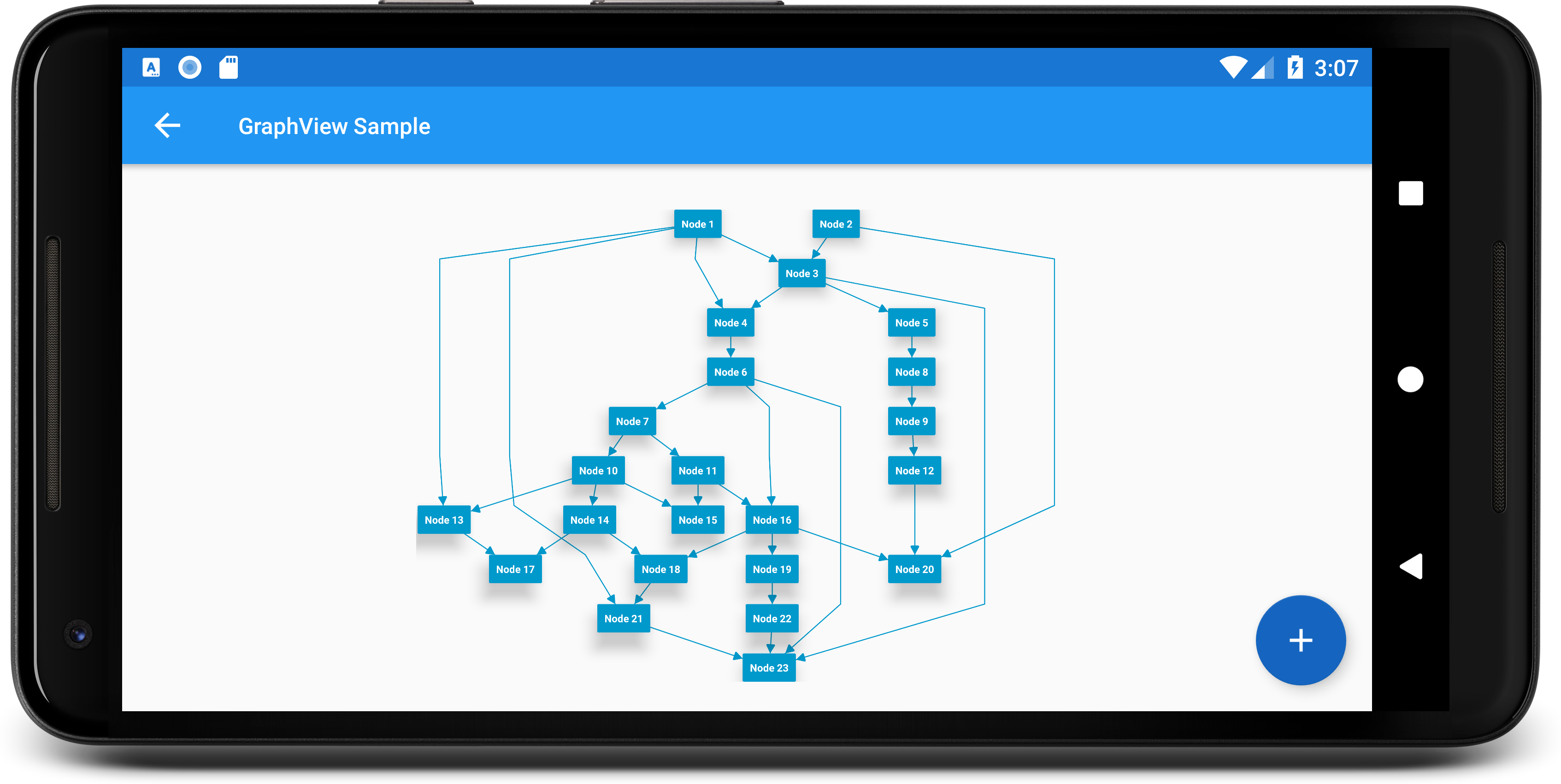Team-Blox / Graphview
Programming Languages
Projects that are alternatives of or similar to Graphview
GraphView
Android GraphView is used to display data in graph structures.
Overview
The library is designed to support different graph layouts and currently works with small graphs only.
This project is currently experimental and the API subject to breaking changes without notice.
Download
dependencies {
implementation 'de.blox:graphview:0.7.1'
}
Layouts
Tree
Uses Walker's algorithm with Buchheim's runtime improvements (BuchheimWalkerAlgorithm class). Supports different orientations. All you have to do is using the BuchheimWalkerConfiguration.Builder.setOrientation(int) with either ORIENTATION_LEFT_RIGHT, ORIENTATION_RIGHT_LEFT, ORIENTATION_TOP_BOTTOM and
ORIENTATION_BOTTOM_TOP (default). Furthermore parameters like sibling-, level-, subtree separation can be set.
Directed graph
Directed graph drawing by simulating attraction/repulsion forces. For this the algorithm by Fruchterman and Reingold (FruchtermanReingoldAlgorithm class) was implemented.
Layered graph
Algorithm from Sugiyama et al. for drawing multilayer graphs, taking advantage of the hierarchical structure of the graph (SugiyamaAlgorithm class). You can also set the parameters for node and level separation using the SugiyamaConfiguration.Builder.
Usage
Using GraphView is not much different than using RecyclerView. Add GraphView to your layout file.
<com.otaliastudios.zoom.ZoomLayout
android:layout_width="match_parent"
android:layout_height="match_parent"
app:hasClickableChildren="true">
<de.blox.graphview.GraphView
android:id="@+id/graph"
android:layout_width="match_parent"
android:layout_height="match_parent"
app:lineColor="@android:color/holo_blue_dark"
app:lineThickness="2dp"
app:useMaxSize="true" />
</com.otaliastudios.zoom.ZoomLayout>
Currently GraphView must be used together with a Zoom Engine like ZoomLayout. To change the zoom values just use the different attributes described in the ZoomLayout project site.
Then define the node layout, e.g. node.xml. You can make the node Layout as complex as you want.
<TextView xmlns:android="http://schemas.android.com/apk/res/android"
android:id="@+id/text"
android:layout_width="wrap_content"
android:layout_height="wrap_content" />
To create a graph, we need to instantiate the Graph class. Next bind your graph to GraphView, for that you must extend from the GraphView.Adapter class.
public class GraphActivity extends AppCompatActivity {
@Override
protected void onCreate(Bundle savedInstanceState) {
super.onCreate(savedInstanceState);
setContentView(R.layout.activity_main);
GraphView graphView = findViewById(R.id.graph);
// example tree
final Graph graph = new Graph();
final Node node1 = new Node("Parent");
final Node node2 = new Node("Child 1");
final Node node3 = new Node("Child 2");
graph.addEdge(node1, node2);
graph.addEdge(node1, node3);
// you can set the graph via the constructor or use the adapter.setGraph(Graph) method
GraphAdapter adapter = new GraphAdapter<GraphView.ViewHolder>(graph) {
@NonNull
@Override
public GraphView.ViewHolder onCreateViewHolder(ViewGroup parent, int viewType) {
final View view = LayoutInflater.from(parent.getContext()).inflate(R.layout.node, parent, false);
return new SimpleViewHolder(view);
}
@Override
public void onBindViewHolder(GraphView.ViewHolder viewHolder, Object data, int position) {
((SimpleViewHolder) viewHolder).textView.setText(data.toString());
}
};
graphView.setAdapter(adapter);
// set the algorithm here
final BuchheimWalkerConfiguration configuration = new BuchheimWalkerConfiguration.Builder()
.setSiblingSeparation(100)
.setLevelSeparation(300)
.setSubtreeSeparation(300)
.setOrientation(BuchheimWalkerConfiguration.ORIENTATION_TOP_BOTTOM)
.build();
graphView.setLayout(new BuchheimWalkerAlgorithm(configuration));
}
}
Your ViewHolder class should extend from GraphView.ViewHolder:
class SimpleViewHolder extends GraphView.ViewHolder {
TextView textView;
SimpleViewHolder(View itemView) {
super(itemView);
textView = itemView.findViewById(R.id.text);
}
}
Customization
To use the custom attributes you have to add the namespace first: xmlns:app="http://schemas.android.com/apk/res-auto"
| Attribute | Format | Example | Explanation |
|---|---|---|---|
| lineThickness | Dimension | 10dp | Set how thick the connection lines should be |
| lineColor | Color | "@android:color/holo_red_dark" | Set the color of the connection lines |
| useMaxSize | Boolean | true | Use the same size for each node |
Each of the attributes has a corresponding setter in the GraphView class, if you want to use it programmatically.
Examples
Rooted Tree
Directed Graph
Layered Graph
License
Copyright 2020 Team-Blox
Licensed under the Apache License, Version 2.0 (the "License");
you may not use this file except in compliance with the License.
You may obtain a copy of the License at
http://www.apache.org/licenses/LICENSE-2.0
Unless required by applicable law or agreed to in writing, software
distributed under the License is distributed on an "AS IS" BASIS,
WITHOUT WARRANTIES OR CONDITIONS OF ANY KIND, either express or implied.
See the License for the specific language governing permissions and
limitations under the License.




